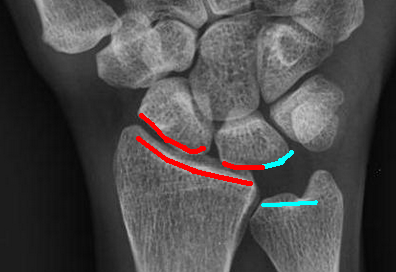File:Negative ulnar variance.png
Negative_ulnar_variance.png (396 × 272 pixels, file size: 101 KB, MIME type: image/png)
Summary
Negative ulnar variance. This patient has negative ulnar variance, that is, the ulnar does not reach as far distally as the radius. Here, the entire articulation is given by the red lines. The blue lines represent the articular area not used because the ulna is too proximal. In this anatomic configuration the carpus articulates with the radius alone, thereby creating a smaller contact area for the lunate, with resultant greater pressure on it. (Pressure, is of course, force/area; and a smaller area for a given force leads to increased pressure.) In turn, the bone is more apt to fail mechanically.
From https://orthopaedia.com/page/Kienbocks-disease
Licencing
This work is licensed under the Creative Commons Attribution-NonCommercial-ShareAlike License.
File history
Click on a date/time to view the file as it appeared at that time.
| Date/Time | Thumbnail | Dimensions | User | Comment | |
|---|---|---|---|---|---|
| current | 19:24, 3 April 2022 |  | 396 × 272 (101 KB) | Jeremy (talk | contribs) | Negative ulnar variance. This patient has negative ulnar variance, that is, the ulnar does not reach as far distally as the radius. Here, the entire articulation is given by the red lines. The blue lines represent the articular area not used because the ulna is too proximal. In this anatomic configuration the carpus articulates with the radius alone, thereby creating a smaller contact area for the lunate, with resultant greater pressure on it. (Pressure, is of course, force/area; and a smalle... |
You cannot overwrite this file.
File usage
The following page uses this file:


